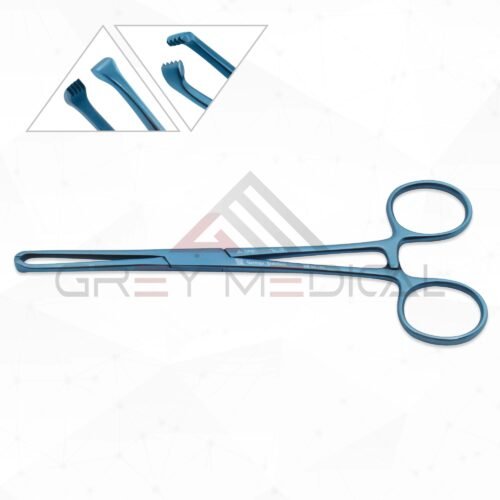Allis Clamp: A Versatile Surgical Instrument
Allis Clamp: A Versatile Surgical Instrument
Blog Article
The Allis clamp, also known as the Allis tissue forceps, is a widely used surgical instrument designed for grasping and holding tissues during various surgical procedures. Named after Oscar Allis, an American surgeon, this tool is recognized for its precision and ability to securely hold tissues without causing significant damage. Allis clamp unique design and functionality make it an essential tool in operating rooms across various medical disciplines.

Design and Features
The Allis clamp is a versatile instrument with features that make it suitable for a range of surgical applications:
- Toothed Jaws:
- The jaws of the Allis clamp are equipped with interlocking teeth. These teeth are typically serrated and designed to provide a firm grip on tissues, ensuring they do not slip during surgical manipulation.
- Locking Mechanism:
- The handles of the clamp feature a ratchet locking system that allows surgeons to maintain consistent pressure on tissues without continuous manual effort.
- Curved or Straight Configuration:
- The instrument is available in both straight and curved configurations, providing flexibility to adapt to different surgical needs.
- Ergonomic Handles:
- The handles are designed for comfort and control, enabling precise manipulation during delicate procedures.
- Material:
- Constructed from high-quality surgical-grade stainless steel, the Allis clamp is durable, corrosion-resistant, and autoclavable for repeated use in sterile environments.
- Size Variations:
- The clamp comes in various lengths, typically ranging from 6 inches (15 cm) to 8 inches (20 cm), allowing for use in both superficial and deep surgical sites.
Applications in Surgery
The Allis clamp is a versatile tool with a wide range of applications in surgical practice:
1. Grasping Tissues
- The toothed design of the Allis clamp makes it ideal for holding and grasping soft tissues, such as fascia, tendons, and muscle layers. It provides a secure grip, enabling surgeons to manipulate tissues effectively during procedures.
2. General Surgery
- Commonly used in abdominal surgeries, the Allis clamp is often employed to hold or retract tissue layers while providing access to deeper anatomical structures.
3. Gynecological Procedures
- In gynecology, the clamp is used to grasp and hold tissues during procedures like hysterectomies, dilation and curettage (D&C), or pelvic surgeries.
4. Bowel and Intestinal Surgery
- The Allis clamp is particularly useful in bowel resections or intestinal surgeries, where it holds segments of tissue without causing excessive trauma.
5. Tumor and Mass Removal
- During tumor excisions, the clamp provides a firm grip on the mass, allowing for precise dissection and removal.
6. Veterinary Use
- The instrument is also employed in veterinary surgeries for similar purposes, such as tissue handling and manipulation.
Advantages of the Allis Clamp
The Allis clamp offers several benefits that make it a preferred choice for surgeons:
- Secure Grip:
- The toothed jaws ensure a strong hold on tissues, preventing slippage during critical procedures.
- Tissue Stability:
- The locking mechanism allows the clamp to hold tissues firmly in place, providing stability and improving surgical precision.
- Versatility:
- Suitable for various tissues and surgical procedures, the Allis clamp is a multipurpose tool in the operating room.
- Durability:
- Made from high-quality materials, the clamp can withstand repeated use and sterilization, ensuring long-term reliability.
- Reduced Fatigue:
- The ergonomic design and locking system minimize hand fatigue during prolonged surgeries.
Limitations and Precautions
While the Allis clamp is a valuable instrument, there are certain limitations and precautions to consider:
- Tissue Trauma:
- The toothed jaws can cause trauma to delicate tissues. Surgeons must exercise caution when using the instrument on fragile or sensitive structures.
- Specific Use:
- The clamp is best suited for tissues that will be excised or are less delicate. For more sensitive tissues, alternative instruments like Babcock forceps may be preferable.
- Regular Maintenance:
- Proper cleaning, sterilization, and inspection are essential to ensure the instrument remains functional and safe to use.
Maintenance and Care
To ensure the longevity and performance of the Allis clamp, proper maintenance is crucial:
- Cleaning:
- Thoroughly clean the instrument after each use to remove blood, tissue, and other debris. Ultrasonic cleaning is recommended for intricate parts.
- Sterilization:
- Sterilize the clamp using autoclaving or other approved methods to maintain aseptic conditions.
- Inspection:
- Regularly inspect the jaws, teeth, and locking mechanism for signs of wear or damage. Replace or repair the instrument as necessary.
- Storage:
- Store the clamp in a clean, dry, and sterile environment to prevent contamination or corrosion.
Conclusion
The Allis clamp is a versatile and reliable surgical instrument widely used for grasping and holding tissues during a variety of procedures. Its robust design, locking mechanism, and adaptability make it an indispensable tool in the operating room. While it is ideal for handling tougher tissues, careful use and maintenance are essential to ensure its effectiveness and longevity. By providing surgeons with a secure and efficient way to manipulate tissues, the Allis clamp continues to be a cornerstone of surgical practice across multiple disciplines. Report this page